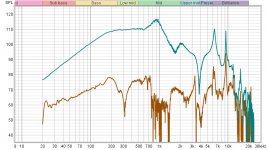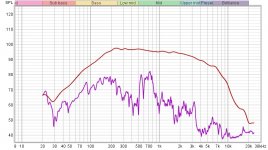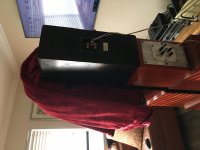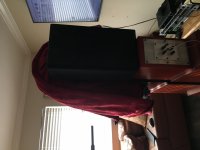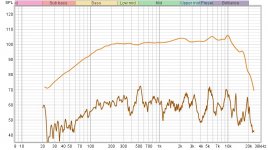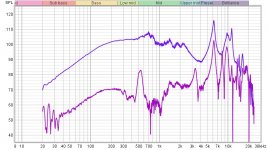Is it possible the higher frequency cancellation depends more on the mic position here and the lower frequencies more on driver (resonance or motor related) consistency?
The Umik-1 usb mic is automatically calibrated for spl readings when used with REW...]
Thanks. Nice feature for an integrated USB mic, and with no obvious downside (size and weight excepted). I was blinkered by being a user of a phantom powered analog mic.
Is it possible the higher frequency cancellation depends more on the mic position here and the lower frequencies more on driver (resonance or motor related) consistency?
Yes, absolutely. This is an mtm, so the mic is very off axis from all four drivers. I plan on fixing this by unhooking two of the drivers(bottom opposing)and placing the mic directly between the two top opposing drivers. Since this is simply to get an idea of how well they cancel out, the absolute spl is irrelevant. If it was relevant, you would only need to add 3db, but it’s not in this case. I will also get the speakers up off the floor on the next measurement. Finding out how well they cancel each other out is key to making sense of the other measurements, so that’s my next move.
Last edited:
Measurements with the bottom opposing midbasses disconnected and the mic centered between the two top opposing midbass drivers. Lowpass crossover engaged at 1.5khz.
About 30db of cancelation or more from about 80hz and up.
When I disconnected the lower drivers, I checked to see if there was any bracing, and there was not! I am totally shocked by this! The panels are probably reproducing lower frequencies loud enough to interfere with the direct output of the speaker, so the bump in the midbass on the side panel output could very easily be real, in a Harbeth kind of way🙂
I will do more measurements to try to verify what I measured earlier.
About 30db of cancelation or more from about 80hz and up.
When I disconnected the lower drivers, I checked to see if there was any bracing, and there was not! I am totally shocked by this! The panels are probably reproducing lower frequencies loud enough to interfere with the direct output of the speaker, so the bump in the midbass on the side panel output could very easily be real, in a Harbeth kind of way🙂
I will do more measurements to try to verify what I measured earlier.
Attachments
Last edited:
I don't think it's a dip at 300hz, I think it's a peak at 200hz and another at 400hz and above caused by the box resonances interfering with the null that would have been at the 300hz level all the way across. Go back and look at the mic box resonance measurements. It's not a perfect resemblance because it's panel noise coming from the front panel and not the side. Hopefully, more measurements will bare things out.
Last edited:
I have a pair of old KEF Q floorstander cabinets, that I cut the separate, hollow bottom half off of, to make them more bookshelf size. These are made from 5/8" cheap MDF and they really ring badly; you could put on a handle and use one for a percussion instrument in a marching band, hitting it with a rubber ball ended drumstick...
I want to investigate the effectiveness of using an elastomer to float-mount a FR driver, versus hard-screwing it to the front baffle. I've assembled the elastomer to one and could use a piece of wood in the same way for the other, for a stiff / not so stiff coupling factor change.
The cab sides are the most ringy and I was thinking of a close mic'd measurement of one side, with the box on a stand outdoors, with it turned 90 degrees. Would this be a valid way to A/B compare, to see if elastomeric speaker mounting diminishes force conducted into the cabinet from the speaker frame - and re-radiating from the side panels?
My apologies if it seems I'm hijacking. A simple yes or no would suffice. I'm pretty sure these cabs are unlistenable as-is, however their egregiously bad properties might lend itself to be useful for an experiment - before I break them down to fit the garbage can...
I want to investigate the effectiveness of using an elastomer to float-mount a FR driver, versus hard-screwing it to the front baffle. I've assembled the elastomer to one and could use a piece of wood in the same way for the other, for a stiff / not so stiff coupling factor change.
The cab sides are the most ringy and I was thinking of a close mic'd measurement of one side, with the box on a stand outdoors, with it turned 90 degrees. Would this be a valid way to A/B compare, to see if elastomeric speaker mounting diminishes force conducted into the cabinet from the speaker frame - and re-radiating from the side panels?
My apologies if it seems I'm hijacking. A simple yes or no would suffice. I'm pretty sure these cabs are unlistenable as-is, however their egregiously bad properties might lend itself to be useful for an experiment - before I break them down to fit the garbage can...
Last edited:
I own a pair of Q100’s, so I know what you’re talking about. The drivers are relatively expensive, so they had to cut corners as much as they could on the cabinets and crossovers to get them down to that price point. Just act like you own a pair of Harbeth’s. People spend thousands to get a cabinet exactly like that🙂
I would think an elastomer compound could help, but not very much. Kind of like frosting on a burnt cake🙂
I would think an elastomer compound could help, but not very much. Kind of like frosting on a burnt cake🙂
Last edited:
Oh, that's cold!! But knowing Harbeth, accurate. 😀
I see what you mean about it not being a null circa 300 Hz but peaks on either side. But I'm not fully convinced. In the first plot you posted it looks very much like a cancellation null. And in the second plot (smoothed) why does the response stop at 700Hz in the opposite polarity plot as compared to 1kHz on the same polarity plot?
This is were contact mics or accelerometers would be a big help. What do you feel with your fingertips?
I see what you mean about it not being a null circa 300 Hz but peaks on either side. But I'm not fully convinced. In the first plot you posted it looks very much like a cancellation null. And in the second plot (smoothed) why does the response stop at 700Hz in the opposite polarity plot as compared to 1kHz on the same polarity plot?
This is were contact mics or accelerometers would be a big help. What do you feel with your fingertips?
Wide open, with no smoothing. Definitely more to work with here. Yes, that is a complete null at 315hz, but I still also think the bumps above and below are at least partly from contamination by the audible cabinet resonances. My next set of measurements will once again be the cabinet sidewall with both channels out of phase, and yes, I feel both vibrations(200hz and the 500 to 700hz) perfectly with my fingers while running the sweeps. I can't stress just how loudly these cabinet sidewalls are reproducing those frequencies into the room with the "correlated", but out of phase pink noise.
Attachments
Thanks, that makes things clearer. What's your next step in measuring what's coming from the box walls?
This is a fairly effective and inexpensive way to see what the panel is putting out vs on axis. This time the measurement is at 12" for both. this allows the mtm midbasses to more accurately add up on axis. One again, John Atkinson’s accelerometer measurements are useful to compare.
Attachments
Last edited:
Kinda looks like the cabinets are semi-transparent below 200Hz and have a healthy resonance centered on 650 Hz
Yep, the resonant frequency of the midbass drivers is 80hz, so there’s not a ton of output below 100hz, but yes, definitely pretty transparent at 200hz and below that point. My next set of measurements will be on my speakers that the Dunlavy’s are sitting directly on, which was an all out effort on controlling mechanical and internal acoustical resonances. It will be an interesting comparison.
Last edited:
Here we go. Kind of scary doing this after all the work I put into them. Same exact conditions as the previous Dunlavy measurements. Interesting high Q peak at 500hz(because of the dips on both sides, it looks worse than it is), but almost 30db down in level. Everything else is very good across the board. I use these in the system from 200hz to 2khz, but they're running wide open here
Attachments
Last edited:
Driver cancelation measurement. Like with the dunlavy's during this measurement, the box resonance(extremely closed mic'd against the null at about 3mm so it looks really bad) is sneaking into what would have otherwise been a very good null result. At least that's what I imagine is happening.
Attachments
Last edited:
- Home
- Loudspeakers
- Multi-Way
- Accelerometers to measure panel vibrations?

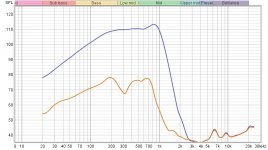
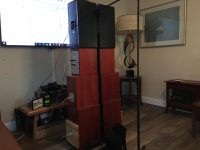
 Still the dip there just above 300Hz. Wonder what that is?
Still the dip there just above 300Hz. Wonder what that is?